PINNED - Lithium battery conversion/info
Re: PINNED - Lithium battery conversion/info
Yes, I should have been clearer - SS fixings are fine, I use them in my Lithium pack. And an SS washer probably won't hurt. But an SS connector (bus bar) probably isn't a good idea.
A 0.8mm thick nickel plated copper connecting strip 15mm wide and 70mm long between holes has a resistance of about 0.1mOhms, so at 100A would drop 0.1v and dissipate 1W - the SS equivalent would drop 0.5v and dissipate 58W! Given there are at least 7 in a 24v pack that's 3.5v off the top and a lot of heat to shift...
A 0.8mm thick nickel plated copper connecting strip 15mm wide and 70mm long between holes has a resistance of about 0.1mOhms, so at 100A would drop 0.1v and dissipate 1W - the SS equivalent would drop 0.5v and dissipate 58W! Given there are at least 7 in a 24v pack that's 3.5v off the top and a lot of heat to shift...
C5/6 A (complete)
Puma 40, 75Ah LiFePO4 (pic is on tour @ Whistler, BC)
Puma 40 backup, 73Ah MK (for now)
Spectra Plus (weedy 40Ah MK)
Puma 40, 75Ah LiFePO4 (pic is on tour @ Whistler, BC)
Puma 40 backup, 73Ah MK (for now)
Spectra Plus (weedy 40Ah MK)
-

Irving - Posts: 2114
- Joined: 04 Dec 2012, 11:51
- Location: NW London
Re: PINNED - Lithium battery conversion/info
I have a question. I recently found a supplier of lifepo4 batteries that are similar in size of the lead acid. The chair that I use around the house is beat up pretty bad but still does what I need it to do. The supplier was all ready to make a deal on 2 12v 60ah until I told him it was a 24v system and that I would be charging them separately as 12v and with a charger specifically designed to charge lifepo4 batteries. He said that 12v lifepo4 batteries cannot be wired to supply 24v. They are not the same as lead acid was his exact words. I asked repeatedly to explain why for my personal information and that I didnt dispute his word. I never got a reply to explain. Im assuming that whenever he found out they were for a powerchair that he got scared of a liability issue. Is there a difference or are they just trying to protect the company?
- hensonshome
- Posts: 41
- Joined: 02 Jul 2017, 14:28
Re: PINNED - Lithium battery conversion/info
I have a question. I recently found a supplier of lifepo4 batteries that are similar in size of the lead acid.
Theres loads. Non are of any use as a lead brick replacement. Almost all cannot supply enough current, and the internal protection will keep chopping off power unexpectedly and the capacity of those in Ah is usually no better than the lead battery. you are replacing. Makng them a very expensive unreliable option. And one where you throw away all the advantages of going to lithium in the first place. That being much more range, fast charge capabiity, and a decade of service life. You wont see any of this. At great cost!
The chair that I use around the house is beat up pretty bad but still does what I need it to do. The supplier was all ready to make a deal on 2 12v 60ah until I told him it was a 24v system and that I would be charging them separately as 12v and with a charger specifically designed to charge lifepo4 batteries.
Why? Also, a charger that is any use for charging lifepo4 cells must also be a balancing and prograable charger. So isnt simple, and will need ideally to be able to charge at up to 40A as the ones we use here can.
He said that 12v lifepo4 batteries cannot be wired to supply 24v. They are not the same as lead acid was his exact words. I asked repeatedly to explain why for my personal information and that I didnt dispute his word. I never got a reply to explain. Im assuming that whenever he found out they were for a powerchair that he got scared of a liability issue. Is there a difference or are they just trying to protect the company?
Neither. As usual, you are speaking to a moron. Of coyurse they can be wired as any voltage.
My laptop is 21V. My drill is 12.6V. My chairs are 45V and 24V. All depends on charge system and cell balancing system. Most 12V lead brick replacements can be connected in series for 12, 24, 36, 48V. But have other problems. Dont waste your money.
-

Burgerman - Site Admin
- Posts: 69911
- Joined: 27 May 2008, 21:24
- Location: United Kingdom
Re: PINNED - Lithium battery conversion/info
Listen to BM he gives good advice. (Although sometimes I ignore him and think I know best  )
)
-

Scooterman - Posts: 2892
- Joined: 03 Jul 2016, 10:11
- Location: Isle of Wight England
Re: PINNED - Lithium battery conversion/info
Scooterman wrote:The crimped bit of the crimp is the teeny weedy square impression indicated by the arrow. IMHO a pretty shoddy job done by Sunrise. You'd think they'd use one of the Hex type crimping tools.
What is in the photo is NOT a properly used Anderson approved crimper... I am not sure what it is, but it isn't even as good as I can do with my ratchet crimpers that are billed as being for Anderson SB-50 pins, but are NOT approved by Anderson (I purchased them to do the smaller PP 15/30/45 pins)
My crimper makes a single LARGE dent in the side of the crimp barrel, centered on the length of the barrel. The dent is deep enough to be going at least half way into the wire cavity and is about 2/3 the width of the cavity and about 3/4 of it's length....
The 'Official' Anderson crimper makes FOUR dents that are slightly smaller in width and depth but in total probably reduce the internal volume of the cavity more.... The Anderson technical documentation that describes assembly procedures both requires use of the 'Official' crimper and pins that match the wire size and PROHIBITS soldering - and this is on the same thin wall pins that BM insists on soldering.... (Note that they also require appropriate strain relief practices so the cable never gets serious flexing at the crimp...)
I also have one of the hydraulic hex style crimpers, and it allows one to compress the cavity a great deal, but I find requires several cycles while rotating the pin to different positions in order to mash down the 'ears' that form where the two dies come together. (a better die design would prevent most of the 'ear' problem, but would be harder / more expensive to make....) As a result I have seen signs of the barrel starting to crack due to the metal work hardening and fatiguing on a few of the pins I have done....
While I agree w/ BM about the poor quality of most non-professional grade crimps, it is worth noting that almost NONE of the factory stock connectors on modern vehicles are soldered (in most cases the connector manufacturer explicitly prohibits soldering) and that the specs for a lot of 'Mission Critical / Life Critical' military hardware also requires connector pins be crimped by the right tools, and not soldered....
Since I don't have official crimpers for SB-50's and I don't completely trust the ones I have, I DO solder my SB-50's and other cable ends that are larger than AWG10.... Most of my crimpers for smaller sizes are not 'official' but produce professional grade crimps that I feel confident in, so I don't solder them. (But I have an estimated US $3-400 in crimp tooling)
ex-Gooserider
T-5, ASIA-B
Jazzy 1100
Jazzy Select 6
Quickie Q-7
Invacare Mariner
Want to make / get a better chair, ideally one that stands.
Jazzy 1100
Jazzy Select 6
Quickie Q-7
Invacare Mariner
Want to make / get a better chair, ideally one that stands.
-
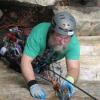
ex-Gooserider - Posts: 6197
- Joined: 15 Feb 2011, 06:17
- Location: Billerica, MA. USA
Re: PINNED - Lithium battery conversion/info
terry2 wrote:Scooterman wrote:You could cut some shims out of an aluminium coke can or similar.
I have just seen a funny way of wiring these up.
A guy across the street who has solar panels.
He bought 4 200 AH\Amp cells like ours for the solar energy.
He used a copper plated washer the exact size of the terminal part, so it's a perfect fit.
He had some thick plated wire and soldered that straight on to the washer
The wire was spread about a 3rd of the washer. Never seen that before, so don't know what to make of it.
I've seen this done, and it is the kind of technique that "works" but is generally viewed as being rather 'sketchy' compared to the 'right' way to do it....
There are several problems
1. The mating surfaces between the washer and other fasteners is probably not going to be smooth and flat, so electrical contact is going to be via tiny points not a larger area like you'd get with a proper terminal...
2. Solder is NOT GLUE!!!! It is not a weld... As such the normal rule is that you should have a good mechanical connection BEFORE soldering - spreading wires out into a 'brush' does not make a good mechanical connection.... If there is any stress load on the cables the joint WILL fail eventually.... In a static install where nothing moves that might not be a problem, but for something moving it is asking for trouble...
3. Unless working very fast and carefully, there is a high probability of having solder wicking up the wire, making it stiff and more prone to breakage at the end of where it wicks....
ex-Gooserider
T-5, ASIA-B
Jazzy 1100
Jazzy Select 6
Quickie Q-7
Invacare Mariner
Want to make / get a better chair, ideally one that stands.
Jazzy 1100
Jazzy Select 6
Quickie Q-7
Invacare Mariner
Want to make / get a better chair, ideally one that stands.
-

ex-Gooserider - Posts: 6197
- Joined: 15 Feb 2011, 06:17
- Location: Billerica, MA. USA
Re: PINNED - Lithium battery conversion/info
3. Unless working very fast and carefully, there is a high probability of having solder wicking up the wire, making it stiff and more prone to breakage at the end of where it wicks....
But thats just as likely as where it exits a connector, crimped, or soldered or otherwise if its SECURELY crimped. So I dont get that.
Also while solder isnt massively strong, it certainly is plenty strong enough when done properly. The copper cables are not a lot stronger, and the solder area is big enough that the cable snaps first if pulled in most types of joint.
For e.g. Worst type of joint/connector, the XT 60 and 90s. I have dozens of lipo connectors soldered only, into tiny half cups, on those XT60 and XT90. They rely totally on the strength and the electrical connection of a properly done tiny area of soldered connection. We use them in quadcopters, helis, airplanes, and yank the connectors apart by the over heated cables running 100 to 150A a dozen times a day. Never saw any of mine fail ever. Even in crashes. Bent and smashed cables, even ripped off the battery. Never the soldered bit. And the soldered connection doesent get any warmer than the abused silicone cable. IF SOLDERED PROPERLY!
- Attachments
-
- images.jpg (13.55 KiB) Viewed 8031 times
-

Burgerman - Site Admin
- Posts: 69911
- Joined: 27 May 2008, 21:24
- Location: United Kingdom
Re: PINNED - Lithium battery conversion/info
ExGooserider wrote:
Note that soldering is prohibited ONLY for open barrel silver plated PP15-45 connectors, all the others are OK to be soldered. Aircraft practice for larger connectors has been to crimp for mechanical support and solder for electrical connectivity and my feeling is that this is also appropriate for Andersons UNLESS you have their crimping tool(s). Strain relief, even to the point of using Anderson's cable clamps for larger connectors, is certainly advisable.
but my memory of what Anderson says was a bit different so I checked their literature. Here are some clips from the Anderson catalog:The Anderson technical documentation that describes assembly procedures both requires use of the 'Official' crimper and pins that match the wire size and PROHIBITS soldering - and this is on the same thin wall pins that BM insists on soldering...
APP® connectors are designed to be crimped and/or soldered to multi-stranded copper conductor wires only.
PP15-45 Silver Plated Power Contacts ... Only closed barrel contacts are suitable for soldering
PP15-45 Contact Termination Methods (same for PP75, same for PP120, and Sb series for contacts)
Crimp³ Wire Contacts
Hand Solder Wire and PCB Contacts
Solder Dip PCB Contacts
Wave Solder PCB Contacts
3 Use APP® recommended tooling only. Alternate tools may adversely affect the
performance of our connectors along with UL and CSA recognition.
Note that soldering is prohibited ONLY for open barrel silver plated PP15-45 connectors, all the others are OK to be soldered. Aircraft practice for larger connectors has been to crimp for mechanical support and solder for electrical connectivity and my feeling is that this is also appropriate for Andersons UNLESS you have their crimping tool(s). Strain relief, even to the point of using Anderson's cable clamps for larger connectors, is certainly advisable.
- LROBBINS
- Posts: 5774
- Joined: 27 Aug 2010, 09:36
- Location: Siena, Italy
Re: PINNED - Lithium battery conversion/info
silver plated PP15-45 connectors
Silver is soft/weak and has some weird alloying reaction with the solder. On that specific connector the silver plate is the weak point. Even so, the difference will be very minor if soldered well I would expect.
-

Burgerman - Site Admin
- Posts: 69911
- Joined: 27 May 2008, 21:24
- Location: United Kingdom
Re: PINNED - Lithium battery conversion/info
shirley_hkg wrote:Scooterman wrote:Has anyone built a lifepo4 pack using cells with an M4 threaded hole?
If so how did it go?
P176 ↓
My long forgotten ultimate G24 form factor 280Ah is back on track, only one balance lead left.
Putting another 75Ah pouch cells together is a task.

No more bus bars. Wires and terminals only.
Initial balance was still messy.
Took two 15% DOD cycles, and now balanced in 10 mins and absorption period to 115mA termination is just another 20 minutes as well.
Encounter a major setback after connecting those cheap unknown quality pouch cells. Discharged to 230Ah and get low voltage warning.
Frustrated , but take it as a blessing in disguise.

Now looking at possibility of extending battery box by another 1.7 cm , to accommodate 24 EVE-LF105 cells to form a 3P8S pack @315Ah/24V ; inside an INVACARE ARROW GB.


That will obstruct the free-wheel lever, but have figured out a solution.
New battery box is on its way. Stay tuned, and wish me luck !

- shirley_hkg
- Posts: 4482
- Joined: 31 Dec 2010, 13:42
Re: PINNED - Lithium battery conversion/info
Are you planning on leaving HK then? Actually looking at the news that may be wise! But not to china.
-

Burgerman - Site Admin
- Posts: 69911
- Joined: 27 May 2008, 21:24
- Location: United Kingdom
Re: PINNED - Lithium battery conversion/info
May be UK as a temporary refuge ? And putting up A Storm 4 Xplore there as a backup too. 
I have a BNO passport ;
British Nationality (Overseas).
Damn.
I have a BNO passport ;
British Nationality (Overseas).
Damn.

- shirley_hkg
- Posts: 4482
- Joined: 31 Dec 2010, 13:42
Re: PINNED - Lithium battery conversion/info
Burgerman wrote:Are you planning on leaving HK then? Actually looking at the news that may be wise! But not to china.

shirley_hkg wrote:May be UK as a temporary refuge ? And putting up A Storm 4 Xplore there as a backup too.
Chair is in Weymouth, a nice part of the world although nowhere in the UK is nice at this time of year.

-

Scooterman - Posts: 2892
- Joined: 03 Jul 2016, 10:11
- Location: Isle of Wight England
Re: PINNED - Lithium battery conversion/info
No rush. I have a Mega 315Ah brick to be finished.

- shirley_hkg
- Posts: 4482
- Joined: 31 Dec 2010, 13:42
Re: PINNED - Lithium battery conversion/info
I dismantled the 180Ah mob scooter lithium pack yesterday and have ditched the horrible stiff pvc 6mm links and m6 copper studs. When I built the pack in hurry back in the spring I put a dab of superglue on the end of each stud and was nervous I wouldn't get them out. But 85% came out with no effort, the remaining were a bit tighter but came out okay with a squirt of freeze spray and penetrating oil.
I will be replacing with silicone, stainless - studs, washers, and nylocs.
Expresso's 200A build gave me the idea that I should be able to use 12 awg for the inter-cell connections? As I will do the series links in parallel again like I did last time and 12 awg is easier to bend
It's a only a single channel controller 120A max, so max current going through each 12 awg cable is only 60A. And previously I have worked out that 10mph speed on the flat mob scooter draws about 20A.
The pack/s have only been in for about 6-9 months and they're filthy, I'll need to do something about that .
.
Trouble is the rear bodywork is one piece which doubles up as battery cover and rear wheel arches. And all the road spray and road crud from the rear wheels get flung up inside the bodywork.
Any suggestions? I was thinking perhaps think polythene over the cells once everything is wired up? I'm in no rush to rebuild the pack as I won't be using the mob scooter again until the spring.
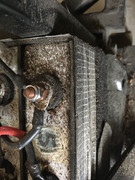
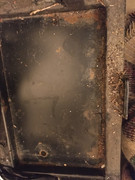
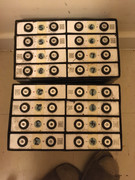
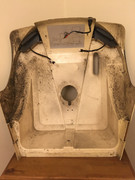
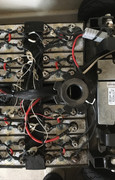
I will be replacing with silicone, stainless - studs, washers, and nylocs.
Expresso's 200A build gave me the idea that I should be able to use 12 awg for the inter-cell connections? As I will do the series links in parallel again like I did last time and 12 awg is easier to bend
It's a only a single channel controller 120A max, so max current going through each 12 awg cable is only 60A. And previously I have worked out that 10mph speed on the flat mob scooter draws about 20A.
The pack/s have only been in for about 6-9 months and they're filthy, I'll need to do something about that
Trouble is the rear bodywork is one piece which doubles up as battery cover and rear wheel arches. And all the road spray and road crud from the rear wheels get flung up inside the bodywork.
Any suggestions? I was thinking perhaps think polythene over the cells once everything is wired up? I'm in no rush to rebuild the pack as I won't be using the mob scooter again until the spring.





-

Scooterman - Posts: 2892
- Joined: 03 Jul 2016, 10:11
- Location: Isle of Wight England
Re: PINNED - Lithium battery conversion/info
BM - Can you give me reassurance then I’ll order some 12 awg locally (aliexpress). 

-

Scooterman - Posts: 2892
- Joined: 03 Jul 2016, 10:11
- Location: Isle of Wight England
Re: PINNED - Lithium battery conversion/info
That's really filthy !
I'm more concerned with the filthy water that came with. It needs shelter.
I'm more concerned with the filthy water that came with. It needs shelter.
- shirley_hkg
- Posts: 4482
- Joined: 31 Dec 2010, 13:42
Re: PINNED - Lithium battery conversion/info
Oh yes I didn’t think of that Shirley
I wonder where it went? Are the cells waterproof?
PS: and all that crud was just the UK summer weather, not winter.
-

Scooterman - Posts: 2892
- Joined: 03 Jul 2016, 10:11
- Location: Isle of Wight England
Re: PINNED - Lithium battery conversion/info
I just had the idea that I could spray a load of your expanding foam over the cells shirley. Good idea/Bad idea? 
-

Scooterman - Posts: 2892
- Joined: 03 Jul 2016, 10:11
- Location: Isle of Wight England
Re: PINNED - Lithium battery conversion/info
I'd say NO.
Simply a thick plastic bag will do. Cut to appropriate size. Hang the sides down and tie it up.
Just let water flow down and drain away.
Simply a thick plastic bag will do. Cut to appropriate size. Hang the sides down and tie it up.
Just let water flow down and drain away.
- shirley_hkg
- Posts: 4482
- Joined: 31 Dec 2010, 13:42
Re: PINNED - Lithium battery conversion/info
>>> BM - Can you give me reassurance then I’ll order some 12 awg locally (aliexpress). 
Use the same as expresso. That looks about right. Or 10swg?
I work in mm... SWG gives me a headache! You want the one thats a size bigger than the PL8 cables. 10swg I think. Personally I would use 6mm2.
Use the same as expresso. That looks about right. Or 10swg?
I work in mm... SWG gives me a headache! You want the one thats a size bigger than the PL8 cables. 10swg I think. Personally I would use 6mm2.
-

Burgerman - Site Admin
- Posts: 69911
- Joined: 27 May 2008, 21:24
- Location: United Kingdom
Re: PINNED - Lithium battery conversion/info
Go for 10awg . Still easy to bend .
- shirley_hkg
- Posts: 4482
- Joined: 31 Dec 2010, 13:42
Re: PINNED - Lithium battery conversion/info
I like this SS M4 flange lock nut.
Large contact ,
Plain base ,
Thick means more threads .
Will grease it for perfection .

Large contact ,
Plain base ,
Thick means more threads .
Will grease it for perfection .

- shirley_hkg
- Posts: 4482
- Joined: 31 Dec 2010, 13:42
Re: PINNED - Lithium battery conversion/info
Burgerman wrote:>>> BM - Can you give me reassurance then I’ll order some 12 awg locally (aliexpress).
Use the same as expresso. That looks about right. Or 10swg?
I work in mm... SWG gives me a headache! You want the one thats a size bigger than the PL8 cables. 10swg I think. Personally I would use 6mm2.
shirley_hkg wrote: Go for 10awg . Still easy to bend .
Will do, thanks guys
shirley_hkg wrote: I'd say NO.
Simply a thick plastic bag will do. Cut to appropriate size. Hang the sides down and tie it up.
Just let water flow down and drain away.
I agree, I think that will be best too.
-

Scooterman - Posts: 2892
- Joined: 03 Jul 2016, 10:11
- Location: Isle of Wight England
Re: PINNED - Lithium battery conversion/info
Do these go open circuit at 100A then reset when current drops below? Or does it reset when internal temp drops below certain value?
I’ve never come across them before.
I’ve never come across them before.
-

Scooterman - Posts: 2892
- Joined: 03 Jul 2016, 10:11
- Location: Isle of Wight England
Re: PINNED - Lithium battery conversion/info
No they go bang and thats it!
-

Burgerman - Site Admin
- Posts: 69911
- Joined: 27 May 2008, 21:24
- Location: United Kingdom
Re: PINNED - Lithium battery conversion/info
Scooterman wrote:Do these go open circuit at 100A then reset when current drops below? Or does it reset when internal temp drops below certain value?
I’ve never come across them before.
You're thinking of polyfuses. Sadly they don't come in 100A+ sizes (AFAIK).
C5/6 A (complete)
Puma 40, 75Ah LiFePO4 (pic is on tour @ Whistler, BC)
Puma 40 backup, 73Ah MK (for now)
Spectra Plus (weedy 40Ah MK)
Puma 40, 75Ah LiFePO4 (pic is on tour @ Whistler, BC)
Puma 40 backup, 73Ah MK (for now)
Spectra Plus (weedy 40Ah MK)
-

Irving - Posts: 2114
- Joined: 04 Dec 2012, 11:51
- Location: NW London
Re: PINNED - Lithium battery conversion/info
Burgerman wrote:No they go bang and thats it!
Oh do they, that's not very good is it. Not easy to change when out in the field
Irving wrote:Scooterman wrote:Do these go open circuit at 100A then reset when current drops below? Or does it reset when internal temp drops below certain value?
I’ve never come across them before.
You're thinking of polyfuses. Sadly they don't come in 100A+ sizes (AFAIK).
Thank you that's interesting.
-

Scooterman - Posts: 2892
- Joined: 03 Jul 2016, 10:11
- Location: Isle of Wight England
Re: PINNED - Lithium battery conversion/info
Are the batteries still ok? Or is there something more suitable. . anyone used this supplier?
I need 8 in total? For my salsa?
http://m.rj-lithium.com/sale-11530426-p ... f-car.html?
I need 8 in total? For my salsa?
http://m.rj-lithium.com/sale-11530426-p ... f-car.html?
- ICEUK
- Posts: 580
- Joined: 27 Apr 2013, 11:51
- Location: UK
Re: PINNED - Lithium battery conversion/info
Burgerman wrote:3. Unless working very fast and carefully, there is a high probability of having solder wicking up the wire, making it stiff and more prone to breakage at the end of where it wicks....
But thats just as likely as where it exits a connector, crimped, or soldered or otherwise if its SECURELY crimped. So I dont get that.
Also while solder isnt massively strong, it certainly is plenty strong enough when done properly. The copper cables are not a lot stronger, and the solder area is big enough that the cable snaps first if pulled in most types of joint.
For e.g. Worst type of joint/connector, the XT 60 and 90s. I have dozens of lipo connectors soldered only, into tiny half cups, on those XT60 and XT90. They rely totally on the strength and the electrical connection of a properly done tiny area of soldered connection. We use them in quadcopters, helis, airplanes, and yank the connectors apart by the over heated cables running 100 to 150A a dozen times a day. Never saw any of mine fail ever. Even in crashes. Bent and smashed cables, even ripped off the battery. Never the soldered bit. And the soldered connection doesent get any warmer than the abused silicone cable. IF SOLDERED PROPERLY!
In the XT-60/90 connectors the cup is at least wrapping part way around the wire so you have increased surface area to distribute the force, and often if some of the wire strands end up on the outside of the cup even more so... The pull also tends to be in-line with the solder joint seam so you have shear forces spread across an area, rather than a 'peeling' action of the wire being pulled away from a washer where the tension is basically hitting just the tiny point where the strand enters the solder blob...
When wire is crimped only, all the strands can move independently as soon as they exit the crimp (but shouldn't have to as there should be strain relief...) but when they are soldered then you have a single stiff blob and the bending forces are concentrated at the point where the strands exit the blob - so it is like repeatedly bending a paper clip wire in the same place....
ex-Gooserider
T-5, ASIA-B
Jazzy 1100
Jazzy Select 6
Quickie Q-7
Invacare Mariner
Want to make / get a better chair, ideally one that stands.
Jazzy 1100
Jazzy Select 6
Quickie Q-7
Invacare Mariner
Want to make / get a better chair, ideally one that stands.
-

ex-Gooserider - Posts: 6197
- Joined: 15 Feb 2011, 06:17
- Location: Billerica, MA. USA
Return to Everything Powerchair
Who is online
Users browsing this forum: Kande_ian, Mr TT, tettralytic, Williamclark77 and 86 guests